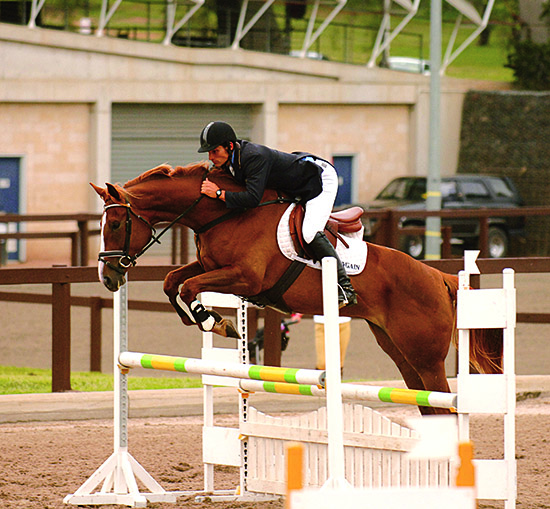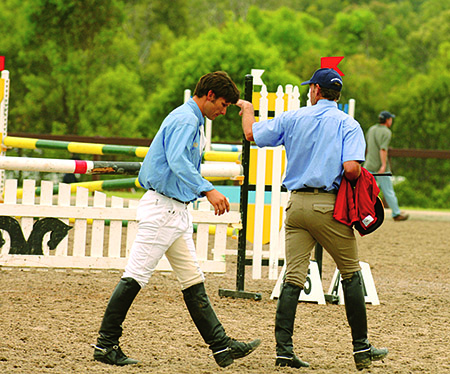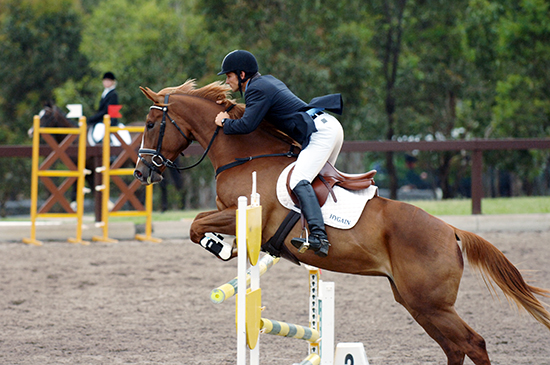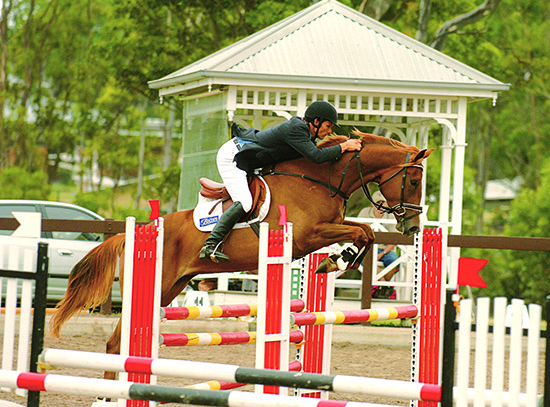Al-Landra takes the next step.
Last month you met Al-Landra, the baby eventer. She was learning to deal with cross country jumps and how to listen to the aids. Meggsie, as she is known, has now graduated to competition and is out at Sydney International Equestrian Centre for a showjumping competition that was part of the big Tempo Showjumping Show. We catch up with Shane Rose to talk about all the scary things you see (and don’t see) when you are a baby out for the first time.
“I took her out last week and everything was, ‘Oh, my god there’s a jump in front of me’… ‘Look, there’s a jump over there.’ She was very unfocussed and shocked, I guess. Every time there was a fence, she was shocked. She jumped reasonably well in the first round, had one down, but that was probably lucky. She jumped a bit out of fear rather than using technique. The second round, second day, she did another one metre five class. The first class I ever took her in was a metre five, so probably a little bigger than she needed it to be. The second day she had a fence down as well but was more focussed and was probably unlucky to have one down. She actually jumped some nice fences on that second day.”
“I then brought her out this week, I only jumped her once during the week, not much at home and she was much more settled and yesterday here at SIEC she actually jumped a clean round. I did have a time penalty. I went outside a fence early on the course. Anyway, I was really happy with that round.”
“I had a rail in the practice arena yesterday, she just got confused. I brought her a little deeper to an oxer and she wasn’t sure if there was enough room for a stride and sort of half went to jump before she was supposed to. She was halfway through taking the last stride and went, ‘Oops I think I was meant to have jumped already,’ and tried to jump in the middle of a stride and made a mess of it. She’s been really, really careful since then.”
“I did a lot of warm-ups today over the oxer again. She was jumping it really well, I was happy. Her only real mistake on course was coming around to the second fence, which was a vertical, and she just never looked like she was backing up from it. When I was warming up with Stuart Tinney, he said, ‘Look, just in the practice arena, soften your hand and let her make a mistake’, and she and she had the rail down on the oxer.”
“I think I probably needed to do that to a vertical in the practice ring, because the first vertical I got to on course, I did that, I softened, and I felt four strides out, she’s not looking at it, she’s going to knock it down. But then I thought in her life’s ambition, having a rail down in a metre five class is not as big as what she’s going to gain from having it down. So I cantered in and if she was going to jump over it she was going to and if she didn’t, well… She ran into it and knocked it down. She got a bit of a shock and I thought she jumped the rest of the round quite nicely.”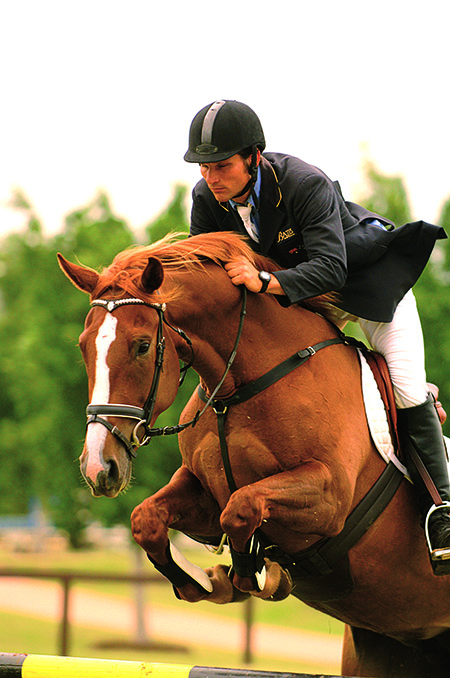
“She jumped some really nice fences, getting much more consistent in her jumps, I think. She was much more focussed and realised that there was probably going to be another jump coming up soon.”
“In the first couple of classes, anytime I had to get a connection to a deeper distance, she struggled. Whereas she’s starting to stay stronger when I need to add in front of a fence. I’m extremely happy with the way she has progressed. Since I started working with her this time in, she has been on edge, not hot, but finding everything a bit much and not coping in her own little way just by getting worried. Since she’s been out to a couple of shows, she seems to have stopped worrying – today she was as relaxed as she’s ever been, whether at home or out.”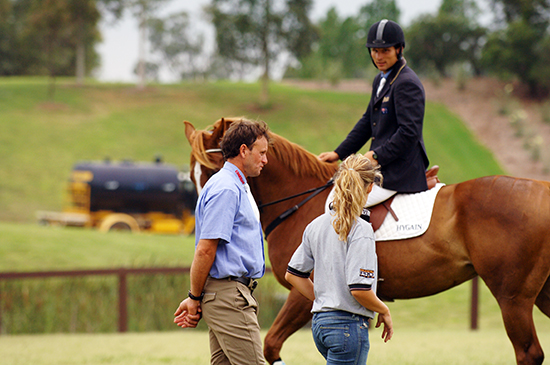
“I think the penny has sunk in with her. I’ll do a couple more showjumping classes – then she’ll do the prelim ODE at SIEC and unless something disastrous happens, she’ll probably go for a spell after that for a couple of months just to have a think about it.”
“In the last fortnight, she has improved more than I would have expected, so to me that’s good. I want to reward her if she goes well. I can’t see anything bad happening because she’s been schooled at home cross country and she’s been out to the showjumping, so I can’t see anything too drastic happening.”
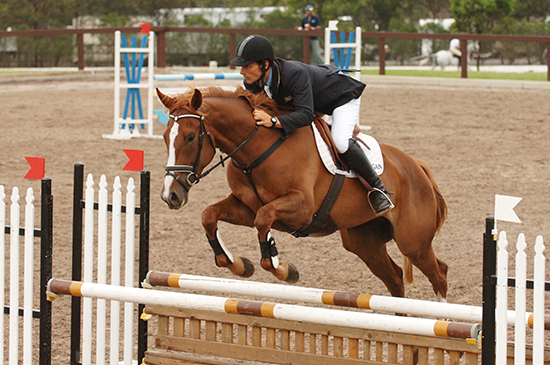 It is amazing at the showjumping competitions, there are so many eventers – there’s Tinney, Rose, Burton, Schaeffer, Bunn, Boyd Martin, Robert Palm. It’s eventer’s day out with this showjumping caper!
It is amazing at the showjumping competitions, there are so many eventers – there’s Tinney, Rose, Burton, Schaeffer, Bunn, Boyd Martin, Robert Palm. It’s eventer’s day out with this showjumping caper!
“I think we realise that if we don’t get better at our showjumping, then we’re not going to be able to win gold medals. I think that the other thing is that because our horses are getting better at showjumping, we can come to the bigger shows and have a bit of fun and jump in the metre twenty-five or metre thirty classes and be competitive. Normally we would have gone down to Berry show which is a great little show on this weekend, and you’d be hunting them around over their heavy gear because it wasn’t going to cost you as much money, but if you’re having a few clear rounds, then it’s probably worth it to come to SIEC and give yourself a test.”
Do you think our showjumping standard is improving amongst our eventers?
“I think it’s improved amazingly in the last four years. You just have to look back to Sydney when we won a gold medal and our best showjumping horse in the team was Jeepster, and Stuart will agree, he’s nowhere near the best showjumper he’s ever had, and the only reason he never had more rails through his career was because Stuart is such a great rider. Now, his showjumping probably wouldn’t be considered good enough to get on a team. How long ago was that, 2000? So in 5 years, the horse that won the gold medal probably wouldn’t even be picked on the team now. Maybe, maybe not, but I think that’s been a definite change.”
Do you think that’s through better horses or better riding?
“I think Wayne’s (Roycroft) direction through the FEI after Rome in 1998 to make the showjumping more technical, has helped with our riding. Now that you have to ride better and people are realising, ‘hey, this horse isn’t very good, I need a better one’. I think the riders realised before the selectors did, that we were going through a transitional phase and realised that we needed more careful horses. I won’t say too much but maybe the team for the World Championships in 2002 and the Olympics in 2004 probably weren’t the right horses to be selected but I won’t go too much into that.”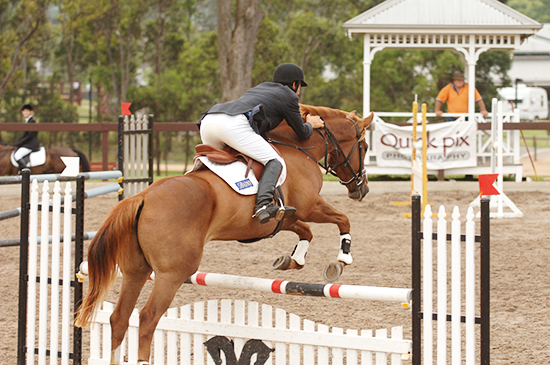 Shane very strongly feels that not all showjumping training techniques are useful for eventers. In particular he stresses that his first priority is that the horse actually jumps – and second is how careful it jumps…
Shane very strongly feels that not all showjumping training techniques are useful for eventers. In particular he stresses that his first priority is that the horse actually jumps – and second is how careful it jumps…
“I’m careful in saying that I don’t want my horses to be careful, of course I want my horses to be careful, but there’s definitely a different philosophy at the basis of showjumping and eventing jumping training. With cross-country penalties, if you have a stop, you cannot win the event. It’s just simple. You are no longer anywhere near the running unless there’s carnage and nowadays that just doesn’t happen. The eventing horses have to jump the fence. Once you teach them that they have to jump the fence, and they’re looking to jump the fence, then you can start to teach them to jump carefully.”
“You go the other way to showjumping, if a horse knocks a pole down, then they can rarely win the class – it is better for them to have a stop. So the philosophy is different in that they have to jump carefully and they have to jump the fence, but not they have jump the fence and then jump carefully.”
“Once you get to a metre, you get to novice, I think the training then becomes very similar. We’re both after the same shape, we’re both after the same carefulness and rideability, but I think the way in which you get to that first bit of training is different. It is the same for dressage and eventing dressage, ultimately we are both after the same thing but a dressage horse doesn’t ever have to jump, it doesn’t ever have to gallop, it doesn’t ever have to do anything but go in a dressage arena and do dressage. So to think that they are going to be the same to train as an event horse is naïve because dressage horses don’t get hot, most of them are not Thoroughbreds, they don’t gallop, they’re not fit for galloping purposes. They’re a different kind of fit.”
“The basis of training for eventing and jumping is you have to be able to control, you have to be able to give a horse a command now and it happens. Whereas for dressage, you know months in advance what dressage test you’re going to do and where that movement is going to start and finish so you can prepare quicker. For eventing, our dressage at the start of their training has to be a little, a little, quicker and more abrupt because if it’s not, we then go and jump and we can’t ride our horses.”
”There’s a balance between in that first part of dressage training as well in that you have to get your horse responsive, quickly responsive, but also not having its neck upside down and against you. There’s obviously that balance as well. For dressage they’ve got the time to spend on getting them really soft and low and floaty movement and things like that because they don’t have to, in about ten metres, get the horse off its head because its about to drop off a cliff.”
“So that’s the three disciplines and eventually they all have the same goal: to have beautiful, soft, engaged horses on the flat, beautiful, scopey, round, bascule careful over jumps but we also have to have them fit to gallop and be brave.”
This article first appeared in the July 2006 issue of The Horse Magazine.


